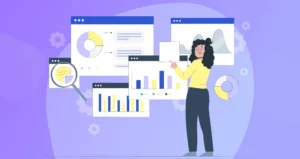Explore insights from data analytics and use advanced analytics tools to create a data-driven culture and make informed decisions in your business.

Source: MITS
Advanced analytics is the semi-autonomous or autonomous examination of data or content via sophisticated tools and techniques beyond traditional business intelligence (BI) methods. It helps to gain insights, make predictions, and generate recommendations. In businesses, advanced analytics offer actionable insights from data, such as market trends and customer preferences. This empowers stakeholders to make data-driven decisions that directly impact their strategies. Data analytics also help businesses by optimizing their performance and increasing their efficiency.
Hidden insights play a crucial role in driving business growth, and unlocking these hidden stories becomes a task for data analysts. This is where data visualization comes into play and helps stakeholders to comprehend raw data with ease.
So, if you have a business and want to take it to the next level, advanced analytics is the way to go. Read to find out more!
The Evolution of Analytics
- The transition from basic to advanced analytics analyzes historical data to understand patterns and trends. On the other hand, advanced analytics uses complex algorithms to make predictions about future trends and behavior. The choice between the two approaches depends on your available resources and business goals. However, the transition and growth from business to advanced analytics is a mighty technological bloom.
- Key differences between traditional and advanced analytics:
| Traditional analytics | Advanced analytics |
| Analyzes past data | Predicts future outcomes |
| Uses basic statistics and reporting | Employs machine learning and artificial intelligence algorithms. |
| Handles structured data | Works with both structured and unstructured data |
| Retrospective and simple | Forward-looking and more complex |
| Offers historical context | Provides insights for decision-making |
- The competitive advantage of embracing advanced analytics: Advanced analytics generates certain competitive advantages. These are:
- Enhanced decision-making
- Improved agility and response time
- Greater return on investment (ROI)
- Consumer satisfaction and customer retention
- Preparedness for unexpected circumstances
- More time to make a strategy
- Data sharing and employee empowerment
Types of Advanced Analytics
The seven types of Advanced Analytics include:
- Descriptive analytics: It is a process of statistical interpretation that is used to analyze historical data to understand the patterns and changes that occur in a business.
- Predictive analytics: Predictive analytics uses data to predict future outcomes via data analysis, artificial intelligence, machine learning, and statistical models.
- Prescriptive analytics: It uses past trends and performances to determine what actions need to be carried out to achieve future goals.
- Diagnostic analytics: It examines data to find the causes of trends. It includes techniques such as data discovery, drill-down, data mining, and correlations.
- Real-time analytics: It applies mathematics and logic to data to provide insights that help make faster and better decisions.
- Natural language processing (NLP) and text analytics: NLP enables computers to understand, generate, and manipulate human language. Text Analytics, on the other hand, uses computer systems to read and comprehend human-written text for business insights.
- Machine learning (ML) and artificial intelligence (AI): ML uses algorithms and data to imitate how humans learn. At the same time, AI is the science of making machines that can think like humans.

Source: Samsung Newsroom
The Business Value of Hidden Insights
Hidden insights help to understand the “why” of a problem. In a scenario where sales are down, and costs are high, identifying the problem is easy, but understanding why the problem has occurred is what hidden insights are all about. It recognizes the root cause of the problem and, consequently, drives better decision-making.
Examples of hidden insights that lead to business success are:
- Customer information
- Insights from your data
- Customer satisfaction insights
- Customer value insights
- Engagement insights
- Conversion rate optimization insights
- Behavioral insights
Gaining these insights might be helpful to understand your business better, but it will not increase your ROI if you do not turn those insights into something actionable. Your senses will only serve you if you act on them.
Data Sources for Advanced Analytics
- Structured vs. unstructured data: Structured data is quantitative, standardized, searchable, and clearly defined, while Unstructured data is qualitative and involves complex search and analysis.
- Internal vs. external data sources: Internal data is the information that comes from within the business, whereas External data comes from the market.
- The role of big data in advanced analytics: In advanced analytics, big data helps extract meaningful insights such as unknown correlations, hidden patterns, customer preferences, and market trends. It provides advantages and helps in making data-informed decisions.
- Data quality and reliability considerations: Data quality measures how appropriately a dataset meets criteria for validity, accuracy, and completeness. Data reliability is the degree to which data and its insights can be trusted and used for decision-making.
Advanced Analytics Tools and Technologies
Advanced analytics tools put self-service analytics into the hands of organizations that want to turn their data warehouses into insights so that they can act on them in real time. The best advanced analytical tools include Alteryx, Microsoft Power BI, Qlik, and SAS.

Source: Qlik
For a thriving business, the right technology stack is required. A technology stack is a set of digital tools an organization uses to meet its daily and long-term goals. To choose the right tech stack, you need to take into consideration the requirement and scope of the project, the time to market, its scalability, and its security.
Besides this, integrating advanced analytics into an employee’s workflow can increase efficiency and accuracy in the decision-making process. Companies use insights from advanced analytics to understand approaches that lead to the best results quickly.
Building a Data-driven Culture
It is essential to promote and encourage a data-driven mindset and behavior to increase competitive advantage. This can be done by:
- Educating your team about data analytics
- Democratizing decision-making
- Building a leadership team to push data initiatives
- Emphasizing the benefits and value of a data-driven company
What is most important is training and upskilling employees for advanced analytics. While building an advanced analytics team, consider the following steps:
- Define your data vision and strategy
- Structure your progressive analytics organization
- Define skills and team roles
- Recruit and assess skills
- Develop and democratize skills
- Retain your analytics talent
Besides this, encouraging data literacy across the organization is the cherry on top!
Source: two
Challenges and Considerations
When it comes to implementing advanced analytics, some of the biggest challenges are:
- Understanding and choosing the correct data
- Having expert staff
- Effective application of techniques
- Responding to results
- Ensuring privacy and security
- Collaborating and sharing
There have been several instances of IT security and privacy breaches that threaten your data, analytics insights, and solutions. Hence, there is a need to incorporate cybersecurity measures into advanced analytics solutions. In addition to this, ensuring the ethical use of advanced analytics signifies that data is used in ways that are fair and accountable. If not, there can be severe consequences for both the business and the individuals.
Future Trends in Advanced Analytics
A few predictions for the future of advanced analytics are:
- More focus on real-time data analysis
- Increase in the use of machine learning algorithms
- More user-friendly techniques
- Greater emphasis on ethical considerations
In addition, some emerging technologies in this field are Artificial intelligence, Edge Computing, Blockchain, Quantum Computing, and Data Governance.

Source: ET Government
Advanced analytics is rapidly growing in popularity in the tech industry. Hence, it is crucial to recognize its importance in making smart business decisions and staying ahead of the curve. Meeting the customer’s needs while mitigating risks is the essential trait of a thriving business, and advanced analytics keeps this process in harmony.
Do you have a business and want to go beyond the traditional maintenance techniques? Do you want enhanced decision-making techniques, more ROI, employee empowerment, and increased customer satisfaction? Advanced Analytics is your answer!
Follow the strategies in the article and push your business toward the heights of digital success!
Are you prepared for the future of advanced analytics in 2024? Let us know on Linkedin, Facebook & Twitter!
FAQs
What are some predictive analytics techniques?
Some predictive analytics techniques are data mining, data warehousing, clustering, predictive modeling, logistic regression, and time series analytics.
Advanced analytics vs Predictive analytics. What is the difference?
Advanced analytics applies automation and AI to deal with complex datasets and produce more profound insights. Predictive analytics is a subset of advanced analytics and uses ML and deep learning to crunch voluminous datasets and predict outcomes.
What are the best-advanced analytics tools?
Some of the best-advanced analytics tools are Altair, Alteryx, Anaconda, Databricks, and Dataiku.
What is Big Data?
Big Data is larger and more complex data sets from new data sources. Due to its enormous volume, traditional data processing software needs help managing it.





